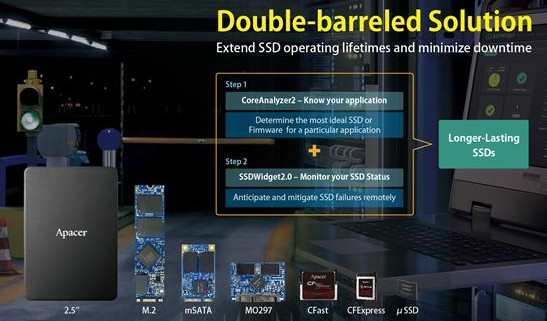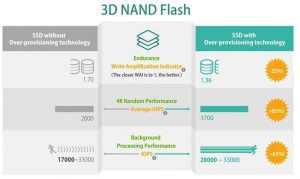Industrial Wide-Temperature 3D NAND Products From Apacer Offer Enticing Opportunities for Industrial Storage Market
With firmware designs and value-adding technologies to extend operation lifetime of 3D NAND solutions
This is a Press Release edited by StorageNewsletter.com on March 29, 2019 at 2:25 pmThe industrial device market is booming, as 5G, IoT, AI and edge computing are expanding rapidly.
All of these technologies require more and more storage space for their data. Moving from 2D SLC or MLC to 3D TLC is similar to changing building patterns from standard homes to high-rise buildings. The vertical construction of 3D NAND technology overcomes the interference caused by the close distances between memory cells found in the 2D NAND process. This offers superior capacity and reliability while also lowering power consumption.
However, 3D NAND also has challenges such as quality, P/E cycles and temperature. To this end, Apacer Technology, Inc. continues to use Toshiba Memory‘s ICs, which offer a total number of 3,000 P/E cycles and support operation at temperatures between -40°C and 85°C. In addition, the company has developed a variety of firmware designs and value-adding technologies that are expected to extend the operation lifetime of 3D NAND solutions.
Over-provisioning technology upgrades 3D NAND performance and durability
The company leverages Over-provisioning (OP) technology to provide better endurance and random performance for its latest 3D NAND SSD solutions. When comparing devices supporting OP to devices that do not, the Write Amplification Indicator (WAI), the number of R/W IO/s, and the Garbage Collection (GC) are useful benchmarks.
In terms of WAI indicators, the adoption of OP in a 128GB product can reduce WAI from 1.68 to 1.47, while WAI for 256GB products using OP is further reduced by 25%. As for the IO/s testing conditions, the SSD is first written for about 500 minutes until it reaches capacity, and then the testing period begins. SSD with OP in these conditions can reach an average IO/s speed of 3,700, while one without OP will be closer to 2,000. And a GC test found that an SSD with OP has a background processing efficiency about 65% better than that of SSD without it.
LDPC ECC engine checks SSD security
The function of the ECC engine helps to ensure that incorrect data is not written to NAND flash during reading and writing, making storage more reliable. Compared to 2D SLC and MLC which use BCH ECC engines to achieve 72-bit ECC rates in 1KB, the firm’s 3D TLC implementation of a low-density parity checking code (LDPC) ECC engine can achieve more than 120 bits of error-correcting capability.
In addition to the higher error-correcting capability, the company’s LDPC ECC engine functions in three distinct levels to further prevent data errors. A complete LDPC ECC process includes both LDPC hard-coding and soft-coding. If both these levels of protection fail, data is still protected by DataRAID technology.This technology automatically generates a parity file that will be present alongside the data. This can be used to correct and restore error data that cannot be corrected by hard-coding or soft-coding, adding another level of protection.
Double-barreled solution
In order to maximize the practical operating lifespan of 3D NAND SSDs, the firm has developed a Double-barreled solution. The first phase is the CoreAnalyzer2 firmware and software package, and the second phase is the SSDWidget2.0 smart monitoring software. Together, these technologies allow customers to select the SSD for their needs and monitor it as it operates.
By taking advantage of the company’s CoreAnalyzer2, customers can discover the SSD which is most suitable for their needs. CoreAnalyzer2 can also recommend customized SSD firmware when necessary. It collects usage and operational data while still maintaining customer privacy, never analyzing what data is recorded but simply the time and conditions under which it was recorded. The firm’s professional technical team use this data to produce a usage analysis, and make suggestions based on this report.
Once an SSD is chosen and deployed, customers can monitor its operation in the real world using the second part of the Double-barreled solution – SSDWidget2.0. This software can be incorporated into the customer’s private server to allow engineers to monitor the status of SSDs in real-time, anticipating the end of an SSD’s operational life and replacing it before it fails to ensure data integrity. This will improve data reliability and, in many cases, reduce manpower and maintenance costs.
For the rapidly growing industrial control field, the company’s industrial-grade 3D NAND storage solutions and value-adding technologies are useful. Whether it’s for IoT, networking, transportation, defense, healthcare or gaming, firm’s SSD will offer abalance of reliability, efficiency and low power consumption.
















 Subscribe to our free daily newsletter
Subscribe to our free daily newsletter

